'Our Navy'
Surviving Films
A.J. West sold his
positive films. He reported that he had made some 56,000 feet of
film
which he listed in a catalogue made in 1913 when the films
were sold.
He wrote in his Autobiography 'Sea Salts and Celluloid' (P 76):
The
'Glasgow firm' mentioned in 1916 was distributor, James Joseph Bennell,
proprietor of: B. B. FILM HIRING SERVICE, 81, Dunlop Street, in Glasgow
(see 'The Bioscope' - Thursday 07 September 1916)
On the closure of the business, the film stock was then sold onwards to
the 'Argosy Film Co. Ltd' in 1917 a company also registered at 81
Dunlop Street on 2 August 1917 (See 'The Bioscope' - Thursday 20
September 1917 page 6)
which was in the film business through the 1920's but was liquidated in
1930. The business then passed to 'Audible Filmcraft' which was itself
wound up in 1931. It is believed that the positive film stock was
transferred from West to B.B. Hiring without completing the purchase.
Though it was
believed for a long time that all of Alfred West's films had been lost,
a number of clips and fragments have
survived. A number of film clips
likely to be part of West's Our Navy are now catalogued by the British
Film Institute and are listed at the foot of this page.
The Internet Movie Database catalogues a large number of clips from 1898 and 1904, though it is not yet known if this means that more material exists in other archives. If material is found, please contact the webmaster of this website and the Wessex Sound and Film Archive in Winchester.
At the foot of this page is an edited sequence of the extant films which was set to music in 2011 by Charles Mauleverer of the Royal College of Music. Charles Mauleverer is a descendant of the West family through Alfred West's sister. The original 'Our Navy' film performances were often accompanied by live music and sound effects, so this recreation is wholly in keeping with the spirit in which they would originally have been shown.
Stationer's
Hall Copyright assertions
In order to assert copyright of his films, Alfred West attached
sections of 35mm nitrate film to an application form which was held at Stationer's
Hall. These are believed to have been passed to the British
Film Institute Archives.
The clips have been preserved and photographed. These are the sources
of some of the animated GIF files below.
Longer clips
There are also links to longer clips (some of which clearly
bear A.J West's studio imprint on the first frame to authenticate
them). The clips have been transcribed from Telecine to MiniDV format
to .AVI format - and then rendered into .FLV format. Higher resolution
versions are are available through the Wessex Sound and Film Archive at
Winchester, Hants.
Original
versions
This list of fragments and clips currently known to be
preserved at the British
Film Institute, is cross-referenced where possible to their
descriptions in A.J.West's printed catalogue 'Life in Our Navy and Our Army' (PDF
Download 5Mb - Transcript Download) which is held at the British
Library as well as some of the frames preserved in the Public Record
Office. (in some cases this is conjectural because some of the
descriptions are slightly at variance with the content)
Sharing of films between companies
Early film makers
shared and cross-marketed their films with each other selling sequences
to make up coherent programmes. This means that it is not always
possible
to infer the actual cinematographer from the company named as having
produced a sequence.
'Our Navy' is specifically mentioned
as a contributor to Charles Urban's portfolio in an article in the Kinematograph Weekly for 14/07/1905
This page from Charles Urban's 1905 catalogue (courtesy of Luke McKernan) lists the 'West's Our Navy Ltd.' series as supplying the footage for the mocked up sequence purporting to show the 'Bombardment of Port Arthur' in the Russo Japanese War.
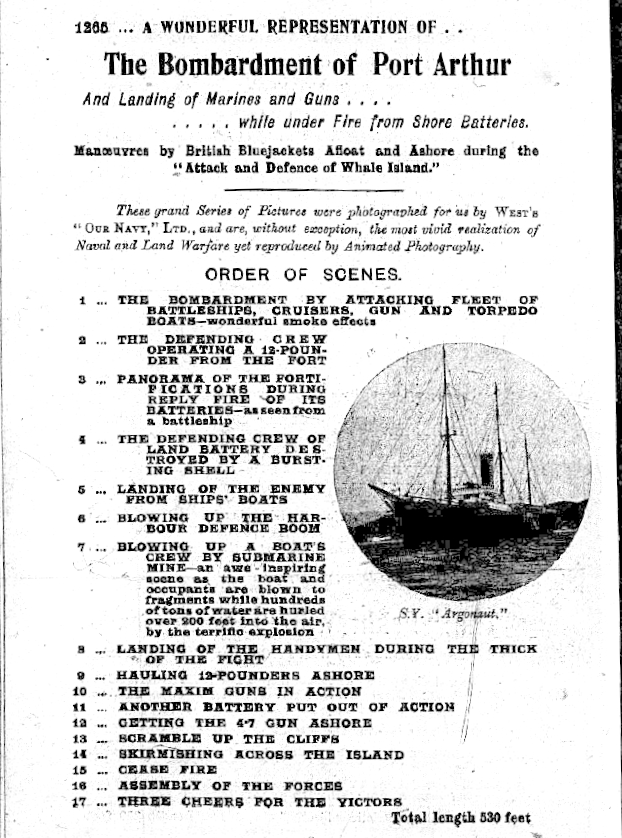
A 'Warm Welcome' from Alfred J. West F.R.G.S.
 Before you start looking at the
clips, Alfred West will send you a smiling
welcome in this short clip taken by his Grandson, Tony Clover, in
1936 on 9mm cine film. Although he took hundreds of thousands of feet
of film during his life, this is the only known film footage of him.
Before you start looking at the
clips, Alfred West will send you a smiling
welcome in this short clip taken by his Grandson, Tony Clover, in
1936 on 9mm cine film. Although he took hundreds of thousands of feet
of film during his life, this is the only known film footage of him.
.
| Cat. Page | Cat. No. | Description and Length |
| 14 | 92 |  'Another
party brings a 9-Pounder gun along the Beach and fire several rounds
out to sea' (75ft') NB - This clip, embossed on the first
frame as 'West & Son', depicts this activity in a parade ground at
Whale Island - the gun is afterwards dismantled along the lines of the Field Gun
competition
at the former Royal Tournament. That tradition started
in 1907 in its current form - so this displays its precursor by 2
years. It is likely that this training was part of the preparations
being made for sending the Naval Brigade to the Boer War which is the
activity commeorated in the Field Gun Competitions. 'Another
party brings a 9-Pounder gun along the Beach and fire several rounds
out to sea' (75ft') NB - This clip, embossed on the first
frame as 'West & Son', depicts this activity in a parade ground at
Whale Island - the gun is afterwards dismantled along the lines of the Field Gun
competition
at the former Royal Tournament. That tradition started
in 1907 in its current form - so this displays its precursor by 2
years. It is likely that this training was part of the preparations
being made for sending the Naval Brigade to the Boer War which is the
activity commeorated in the Field Gun Competitions.Full clip curated at the British Film Institute (N.B. those taking part are wrongly referred to as 'Soldiers' in the main BFI title but correctly referred to in the description beneath) |
| 3 | 40 |  Shows Mr. D. Hearn,
(late Gunner R.N.) who was 90 years of age and who had served under
Rear-Admiral Parker, one of Nelson's
Captains, placing a wreath as
his Centenary Tribute on the spot where Nelson fell, assisted by a
First-Class Petty Officer and two boys of the Royal Seamen's and
Marines Orphanage. One of the boys is believed to be Frank Beggs - the
names of the others are not known. Alfred West's
Great Grandson, David Clover was interviewed by the BBC about the
sequence for the 100th anniversary of the Battle of Trafalgar in 2005. Shows Mr. D. Hearn,
(late Gunner R.N.) who was 90 years of age and who had served under
Rear-Admiral Parker, one of Nelson's
Captains, placing a wreath as
his Centenary Tribute on the spot where Nelson fell, assisted by a
First-Class Petty Officer and two boys of the Royal Seamen's and
Marines Orphanage. One of the boys is believed to be Frank Beggs - the
names of the others are not known. Alfred West's
Great Grandson, David Clover was interviewed by the BBC about the
sequence for the 100th anniversary of the Battle of Trafalgar in 2005.Full Clip |
| to follow | National Archives Reference: COPY 1/436/575 | Underwater
Explosions - Spar Torpedo boat in Fraser Lake, Portsmouth Harbour (6
Frame Fragment of nitrate film in Public Record Office as part of
assertion of copyright) Probably one of West's earliest sequences.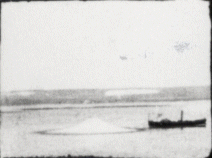 Full clip (NB - The first frame bears the West and Son embossed imprint) |
| 8
57 |
63
394 |
 Combined
clip - 3 scenes found together in archives and attributed to A.J.West's
'Our Navy' series. Full versions available from Wessex Film and Sound
archive at Winchester UK Combined
clip - 3 scenes found together in archives and attributed to A.J.West's
'Our Navy' series. Full versions available from Wessex Film and Sound
archive at Winchester UK
|
| 22 | 150 | 'Others
seek for any pleasure that may be going; the Pier has special
fascination for two twin souls, who watch with great interest two
ladies rinking very gracefully. They try to do the same, but being the
first time they have tried roller skates, the results are somewhat
exciting, certainly very humorous' (9 frames only)
(Strip kept as illustration in margin of 'Sea
Salts and Celluloid' autobiography, derived from Catalogue of 1913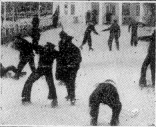 |
| 34 | 241-242 |  'Torpedo
boat ....dash forward and discharge their deadly Whiteheads. There is a
terrific explosion' The battle rages in detail. One of our ships is
torpedoed and has a nasty list, but fights on. Another is like a
floating volcano with her rapid discharge of 12 and 6in guns.' The ship
was in fact a model used for promotional purposes. 'Torpedo
boat ....dash forward and discharge their deadly Whiteheads. There is a
terrific explosion' The battle rages in detail. One of our ships is
torpedoed and has a nasty list, but fights on. Another is like a
floating volcano with her rapid discharge of 12 and 6in guns.' The ship
was in fact a model used for promotional purposes.Full Clip |
| In the clip above, you will see a gunboat steaming from right to left, apparently wearing the Japanese 'Sun' ensign. The flag was actually painted in frame by frame. One frame has been missed out - probably deliberately, and on this, the gunboat is clearly seen wearing the British White Ensign. The sequence starts with a !The scenes appear to have taken in Fountain Lake, near Whale Island in Portsmouth Harbour, and may have been used to simulate a programme about Naval action in the Russo Japanese War (1904-1905). The chalk pit at Paulsgrove near Fort Southwick on Portsdown Hill to the North is clearly visible. | ||
| National Archives Reference: COPY 1/436/578 | Masthead.
(6 Frame Fragment of nitrate film in Public Record Office as part
of assertion of copyright) |
|
| 4 | 49 | The
Turbinia (2 frames only) - from a picture of
the film stock located in contemporary account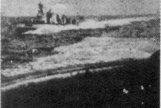 |
| ? | National Archives Reference: COPY 1/436/576 | Fragment
of nitrate film in Public Record Office as part of assertion of
copyright showing sails and a bridge with man walking and sailor
ascending a ladder - animated below |
| National Archives Reference: COPY 1/436/577 | Field
Gun firing and evolution (6 Frame Fragment of nitrate film
in The National Archives as part of assertion of copyright)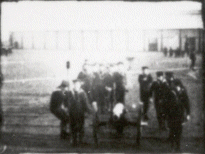 (See first item above for a a fuller clip of which this is a small part) |
|
| National Archives Reference: COPY 1/436/574 | Field
Gun firing on Southsea Common (Queen's Hotel in background). 6
Frame Fragment of nitrate film in The National Archives as part of
assertion of copyright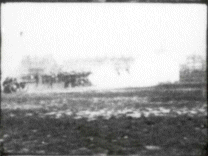 |
|
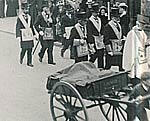 Masonic Procession
along Fawcett Road
Southsea in 1902 . This 4 minute sequence is the longest (and
quite uncharacteristic) Alfred West film preserved to date - it was
discovered in the projection booth of a Portsmouth cinema and carefully
re-photographed frame by frame. It depicts the opening ceremony of St
Matthew's Church, Southsea, on 21 May 1902 (the church was bombed and
destroyed in the Second World War). It is filmed from a single static
position. This clip has been substantially reduced in quality for web
use. A better print is available from the
Wessex Film Archive at Winchester There's a detailed description at
The Hampshire Records Office. The clip is not
mentioned in
Alfred West's 1913 catalogue but was identified from markings on the
film and container. Masonic Procession
along Fawcett Road
Southsea in 1902 . This 4 minute sequence is the longest (and
quite uncharacteristic) Alfred West film preserved to date - it was
discovered in the projection booth of a Portsmouth cinema and carefully
re-photographed frame by frame. It depicts the opening ceremony of St
Matthew's Church, Southsea, on 21 May 1902 (the church was bombed and
destroyed in the Second World War). It is filmed from a single static
position. This clip has been substantially reduced in quality for web
use. A better print is available from the
Wessex Film Archive at Winchester There's a detailed description at
The Hampshire Records Office. The clip is not
mentioned in
Alfred West's 1913 catalogue but was identified from markings on the
film and container.
|
||
|
"A
Tribute To My Great-Great-Great Uncle, Film-maker Alfred West"
The composer Charles Mauleverer, RCM, a great great great nephew of Alfred West, has written music to an edited sequence drawn from some of Alfred West's surviving film - here's the YouTube version.
|
||
British Film Institute (BFI) and other fragments with "Our Navy" connectionsDefiniteSpar TorpedoThe opening frames of this clip show the 'G West' impressed markhttps://player.bfi.org.uk/free/film/watch-torpedo-explosion-1900-online Bluejacket DrillA souvenir postcard from the 'Our Navy' shows depicts this exact location and camera positionhttps://player.bfi.org.uk/free/film/watch-bluejackets-drill-and-exercises-volley-firing-1898-online This sequence is also held at the Huntley Archive Assembling, Firing and dismantling 9 pounder field gun at HMS ExcellentThis sequence is referred to in West's Autobiography. The BFI labelling wrongly identifies the participants as 'Soldiers'. It is also included as a reference clip in the Copyright assertion document at the National Archives.https://player.bfi.org.uk/free/film/watch-soldiers-working-and-firing-a-field-gun-1900-online LikelyMast and SailCopyright assertion clips held in the National Archives appear to show exactly this scene and cadets in this same dress from a slightly different viewpoint.https://player.bfi.org.uk/free/film/watch-mast-and-sail-drill-1900-online Rigging of a sailing shipThis sequence appears to be taken at the same time and has similarities with a deposited clip at the National Archive asserting copyright. The platform at the back is very similar.https://player.bfi.org.uk/free/film/watch-deck-and-rigging-of-a-sailing-ship-1900-online From the Fighting Top of a Battleship in Action
Although this is credited by the BFI to Charles Urban, it is very
similar to
action described by West. By 1909, "Our Navy" was
selling sequences to other distributors including Charles Urban. |
||
